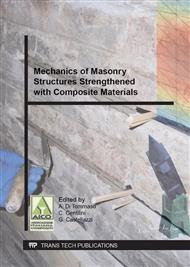p.461
p.470
p.478
p.486
p.494
p.502
p.510
p.518
p.526
FRCM - Strenghtening of Masonry Vaults: The “Duomo Di Colorno” and “Braidense Library” Cases in Italy
Abstract:
In the last decade a re-discovering of the construction techniques and materials belonging to ancient buildings and heritage has grown up.Professionals and researchers have made a strong effort to understand resisting mechanisms in masonry buildings, trying to evaluate the safety factor in presence of vertical and horizontal seismic loads. As a consequence, innovative techniques and materials, as the FRCM, have been introduced to prevent local and global collapse mechanism, increasing the safety of the overall structure.The special cases of “Duomo of Colorno” and the “Braidense Library”, in Italy, are here presented.The XVIII century masonry vaults of the Duomo widely suffered due to a seismic event occurred in 2012 and a relevant crack pattern appeared.A similar situation occurred for the barrel vault of the Braidense Library due to settlement of foundations.In both cases, in order to restore the global resistance of the building, some consolidation interventions have been proposed.One of those is represented by a FRCM net applied on the upper side of the vaults. The system makes use of a carbon bi-directional fiber net inserted in an inorganic pozzolanic matrix, fully compatible with the ancient masonry support.A numerical non-linear analysis of the cathedral and of the barrel vault of the Braidense Library has demonstrated an increment up to 25% in the value of the horizontal loads that cause the formation of the first cracks, if compared with the non-consolidated situation.Furthermore, besides this passive fiber intervention, an innovative active technique called “RAM – Reinforced Arch Method” was applied on the vaults of the Duomo. The use of post-tensioned steel cables, added to the FRCM net, led to a strong increase of the horizontal collapse load.Carbon fibers are able to induce a strong increase in the resistance of the masonry under the tensile stresses caused by seismic loads, avoiding the formation of cracks or plastic hinges.Several tests have been performed on FRCM, according to Standards.In tensile and lap-tensile strength tests, the stress-strain behavior of C-FRCM control coupon specimens is bi-linear as expected. The initial branch of the curve corresponds to the un-cracked specimen, followed by a second branch with a reduced slope, corresponding to the crack specimen.The primary failure mode of the C-FRCM coupon specimens was slippage of the fibers after multiple cracking throughout the length of the specimen, perpendicular to the direction of the load, secondary de-bonding failure mode located at the tab ends was observed in some cases.Furthermore, all tensile and lap-tensile strength coupon tests passed the conditions of acceptance as per the requirements regarding environmental exposure to Freezing and Thawing, and Aging.
Info:
Periodical:
Pages:
494-501
Citation:
Online since:
September 2014
Price:
Сopyright:
© 2015 Trans Tech Publications Ltd. All Rights Reserved
Share:
Citation:


